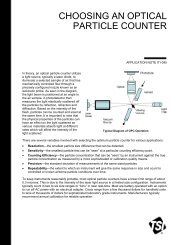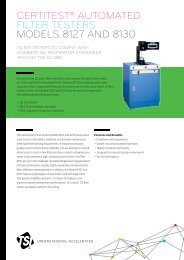Measuring Nanoparticle Exposure - Application Note NSAM-001 - TSI
Measuring Nanoparticle Exposure - Application Note NSAM-001 - TSI
Measuring Nanoparticle Exposure - Application Note NSAM-001 - TSI
You also want an ePaper? Increase the reach of your titles
YUMPU automatically turns print PDFs into web optimized ePapers that Google loves.
The Instrument, the Measurement, and Calibration<br />
The patented Model 3550 <strong>Nanoparticle</strong> Surface Area Monitor * indicates the human lung-deposited<br />
surface area of particles in units of square micrometers per cubic centimeter (µm 2 /cc), corresponding to<br />
tracheobronchial (TB) and alveolar (A) regions of the lung.<br />
The Instrument<br />
The Model 3550 is based on diffusion charging of sampled particles, followed by detection of the charged<br />
aerosol using an electrometer. Using an integral pump, an aerosol sample is drawn into the instrument<br />
through a cyclone with a 1 micrometer (µm) cut point. The sample flow is split, with one stream going<br />
through a set of carbon and HEPA filters and an ionizer to introduce positively charged ions into the a<br />
mixing chamber. The other aerosol flow stream is mixed with the ionized stream in a mixing chamber and<br />
charged aerosol and excess ions move onto an ion trap. The instrument can be switched between<br />
sampling for the tracheobronchial (TB) and alveolar (A) fractions of the total aerosol. This is achieved by<br />
changing the ion trap voltage to either the tracheobronchial (TB) or alveolar (A) response settings. The<br />
ion trap essentially acts as an inlet conditioner or a size-selective sampler for the electrometer, by<br />
collecting the excess ions and particles that are not of a charge state (i.e., surface area/size)<br />
corresponding to the tracheobronchial or alveolar response settings. The aerosol then moves on to the<br />
electrometer for charge measurement. In the electrometer, current is passed from the particles to a<br />
conductive filter and measured by a very sensitive amplifier. The charge measured by the electrometer is<br />
directly proportional to the surface area of the particles passing through the electrometer. A<br />
microprocessor controls the instrument flows and measures various operational parameters and converts<br />
the measurement output into units of square micrometers per cubic centimeter (µm 2 /cm 3 ). While the<br />
Model 3550’s performance is well characterized up to 400 nanometers, the instrument’s response for<br />
larger particles is not as clearly understood.<br />
The Measurement<br />
The Model 3550, when set to either tracheobronchial (TB) or alveolar (A) response settings, matches the<br />
corresponding lung deposition criteria of particles for a reference worker as predicted by human lung<br />
deposition models published by the International Commission on Radiological Protection (ICRP, 1995).<br />
The lung deposition is calculated for a reference worker as defined in a publication by the American<br />
Conference of Governmental Industrial Hygienists (ACGIH, ed. Vincent J.H., 1999).<br />
The Model 3550 does not measure the total active surface area (i.e., Fuch’s surface area) of particles<br />
suspended in air. It indicates the surface area of the fraction of these particles that deposit in either the<br />
tracheobronchial or alveolar regions of the human respiratory tract. The ion trap voltages are optimized to<br />
correspond to the ICRP model-based tracheobronchial and alveolar lung deposition curves, and the<br />
Model 3550 indicates the lung deposited surface area, not the total active surface area of the aerosol<br />
sampled. The current measured by the electrometer downstream of the ion trap in the Model 3550, when<br />
set to either tracheobronchial or alveolar response settings, correlates well with the calculated value of<br />
deposited surface area of particles in these respective regions of the lung as shown in the following<br />
figure.<br />
*U.S. Patents 6,544,484 and 7,812,306<br />
-4-




